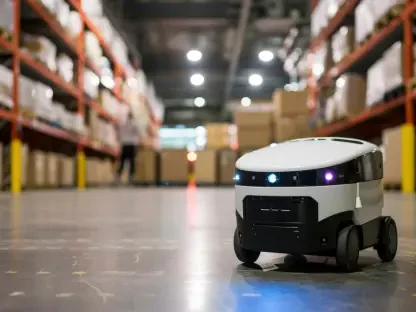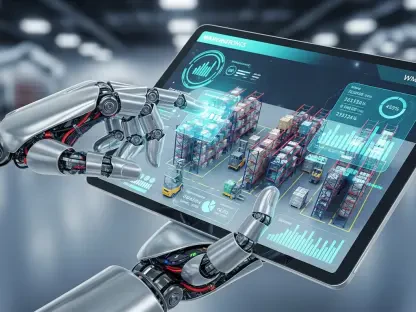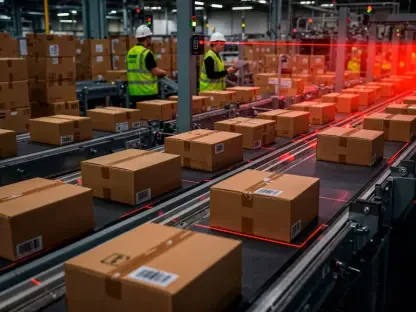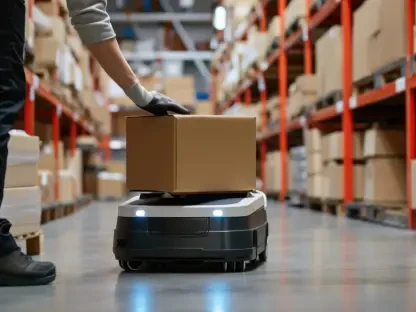Introduction to Physical AI and SAP’s Role in Enterprise Automation
The realm of enterprise automation is undergoing a seismic shift as physical AI, the fusion of artificial intelligence with robotics, transforms how industries operate in dynamic environments. Imagine a manufacturing floor where robots not only assemble components but also adapt to real-time changes in production schedules, addressing labor shortages and minimizing downtime. This scenario is becoming a reality, with SAP, a global leader in business software solutions, spearheading the charge through its Embodied AI initiative. This innovative approach integrates cognitive robotics with enterprise systems, promising unprecedented efficiency across sectors like manufacturing, logistics, and field services.
SAP’s expertise in business applications, such as SAP S/4HANA, positions it uniquely to drive this transformation by embedding business logic into physical operations. The significance of this merger lies in its potential to revolutionize industries facing complex challenges, from supply chain disruptions to operational scalability. Key market players, including robotics companies like NEURA Robotics, ANYbotics, and Unitree Robotics, alongside enablement partners such as Capgemini and HCLTech, are collaborating with SAP to push technological boundaries. Advances in AI-driven adaptability and real-time data integration are fueling this sector’s rapid evolution.
This convergence of AI and robotics is not merely a trend but a fundamental shift toward autonomous operations. Industries are increasingly recognizing the value of systems that can think and act within a business context, reducing human intervention in repetitive or hazardous tasks. As SAP forges ahead with strategic partnerships and pilot projects, the stage is set for a deeper exploration of how physical AI is reshaping enterprise landscapes.
Current Trends and Market Insights in Physical AI
Emerging Trends Shaping Autonomous Operations
The landscape of enterprise automation is pivoting from rigid, task-specific machinery to cognitive systems capable of learning and adapting in real time. This shift is driven by the need for operational resilience in environments where unpredictability is the norm, such as fluctuating demand in warehousing or safety risks in field operations. SAP’s Embodied AI initiative exemplifies this trend, equipping robots with the ability to understand business priorities and respond dynamically to changing conditions.
Emerging technologies like Embodied AI are proving instrumental in tackling persistent challenges, including labor shortages and supply chain bottlenecks. By integrating robots with enterprise software, companies can maintain high service levels even under strain, blending human expertise with robotic precision. This adaptability is particularly critical in sectors like automotive production, where precision and speed are paramount, and in hazardous field operations, where safety is a top concern.
Growth opportunities abound in diverse areas, from optimizing warehouse workflows to automating inspections in high-risk zones like offshore platforms. The industry demand for scalable, intelligent solutions is pushing boundaries, with cognitive robotics offering a pathway to not just efficiency but also innovation. As enterprises seek to future-proof their operations, the focus on real-time adaptability is becoming a defining characteristic of modern automation strategies.
Market Performance and Growth Projections
Early results from SAP’s pilot projects underscore the transformative potential of physical AI, with proof-of-concept applications reporting up to a 50% reduction in unplanned downtime and a 25% boost in productivity. These metrics, derived from real-world implementations in manufacturing and logistics, highlight the tangible benefits of integrating cognitive robotics with business processes. Such outcomes are driving heightened interest across industries eager to replicate these gains.
Market indicators reveal a surging demand for intelligent automation, as companies grapple with global supply chain complexities and workforce constraints. Analysts project significant adoption of physical AI solutions over the coming years, with growth trajectories spanning from now to 2027, fueled by technological advancements and industrial needs. SAP’s expanded ecosystem, encompassing a wide array of robotics and enablement partners, positions it to capture a substantial share of this expanding market.
The potential impact of these initiatives is further amplified by successful pilots that demonstrate scalability and value. As enterprises witness measurable improvements in efficiency and error reduction, confidence in physical AI continues to grow. This momentum suggests a robust future for the sector, with SAP’s strategic collaborations likely to set benchmarks for innovation and implementation across diverse industrial landscapes.
Challenges in Implementing Physical AI Solutions
The path to widespread adoption of physical AI is not without hurdles, particularly in the realm of technology integration. Merging cognitive robotics with existing enterprise systems often requires overcoming compatibility issues and ensuring seamless data flow between digital and physical layers. This technical complexity can pose significant barriers, especially for organizations with legacy infrastructure not designed for such advanced automation.
Beyond technology, market-driven challenges like scalability across varied industries and fluctuating demand add layers of difficulty. Each sector, from logistics to field services, presents unique operational needs that demand customized solutions, stretching resources and expertise. Additionally, the high initial costs of deployment, coupled with the need for extensive training, can deter adoption, particularly among smaller enterprises with limited budgets.
Resistance to change also looms large, with concerns over workforce displacement and the cultural shift required to embrace automation. Addressing these apprehensions necessitates transparent communication about the benefits of human-robot collaboration and the creation of new roles rather than the elimination of existing ones. Strategies such as collaborative partnerships and pilot demonstrations are proving effective in building trust, showcasing value, and paving the way for broader acceptance of physical AI solutions.
Regulatory and Compliance Considerations for Physical AI
Navigating the regulatory landscape is a critical aspect of deploying physical AI in enterprise settings, as autonomous systems must adhere to stringent safety and operational standards. Guidelines governing robotics in industrial environments often focus on minimizing risks to human workers and ensuring reliable performance under diverse conditions. Compliance with these rules is non-negotiable for companies aiming to integrate such technologies without legal or operational setbacks.
Data privacy laws also play a pivotal role, especially as physical AI systems rely on vast amounts of operational data to function effectively. Protecting this information from breaches and ensuring alignment with global regulations, such as GDPR in Europe, is paramount. Moreover, the integration of robotics with enterprise software demands robust security measures to safeguard against cyber threats that could disrupt critical processes.
As regulations evolve, their impact on initiatives like SAP’s Embodied AI becomes increasingly significant. Changes in safety protocols or data handling requirements could necessitate adjustments in deployment strategies or technology design. Staying ahead of these shifts through proactive engagement with regulatory bodies and adherence to best practices is essential for maintaining momentum in the physical AI space and ensuring industry-wide trust.
Future Outlook for Physical AI and Enterprise Robotics
The trajectory of physical AI points toward a future where intelligent automation becomes a cornerstone of enterprise operations, with SAP poised to lead this charge. By embedding business context awareness into robotics, the company is setting a precedent for systems that not only perform tasks but also prioritize and adapt based on real-time needs. This capability is expected to redefine efficiency across manufacturing floors, logistics hubs, and beyond.
Potential disruptors, such as advancements in humanoid and quadruped robotics, alongside AI-driven decision-making, could accelerate this transformation. These innovations promise to expand the scope of tasks robots can handle, from intricate assembly to complex inspections in challenging terrains. As consumer and enterprise preferences lean toward greater efficiency and adaptability, demand for such solutions is likely to surge, reshaping operational paradigms.
Global economic conditions, innovation cycles, and regulatory developments will also influence market growth. Economic stability could spur investment in automation, while rapid technological progress might lower entry barriers for smaller players. Conversely, stringent regulations or geopolitical tensions could introduce delays. Despite these variables, the momentum behind physical AI suggests a robust expansion, with SAP’s collaborative ecosystem well-positioned to navigate future challenges and opportunities.
Conclusion and Strategic Recommendations
Reflecting on the strides made in physical AI, SAP’s Embodied AI initiative stands as a beacon of innovation through its strategic partnerships and pilot successes. The integration of cognitive robotics with business processes has demonstrated remarkable gains in productivity and resilience, setting a high bar for enterprise automation. These efforts underscore the profound impact of blending digital intelligence with physical action across diverse industries.
Looking ahead, enterprises are encouraged to take decisive steps by partnering with ecosystem leaders like SAP to explore physical AI solutions tailored to their unique challenges. Investing in pilot projects offers a low-risk avenue to validate benefits and build internal buy-in for broader adoption. Additionally, prioritizing workforce training to complement robotic systems ensures a harmonious transition, fostering collaboration rather than replacement.
Further consideration is warranted for emerging growth areas such as autonomous warehousing and predictive maintenance in hazardous environments. Allocating resources to these sectors promises substantial returns as demand for intelligent automation escalates. By staying attuned to technological advancements and regulatory shifts, companies can position themselves at the forefront of this transformative wave, leveraging physical AI to achieve operational excellence.









